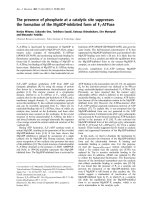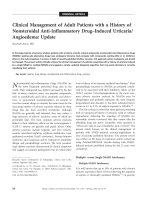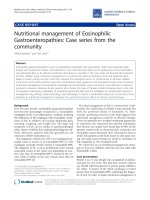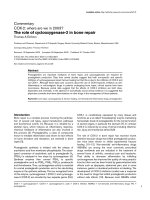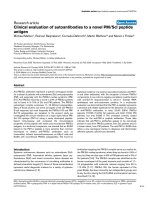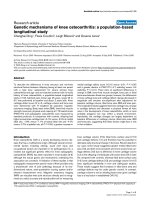Báo cáo y học: "Initial Management of Head Injury: A Comprehensive Guide" doc
Bạn đang xem bản rút gọn của tài liệu. Xem và tải ngay bản đầy đủ của tài liệu tại đây (98.24 KB, 1 trang )
Available online />This book is aimed at the non-neurosurgeon involved in the
immediate care of the head-injured patient. Written by neuro-
surgeons practicing in Malaysia and Australia, it draws heavily
on North American and UK guidelines. The stated aim of the
book is to provide advice to non-specialist clinicians, particu-
larly in developing countries, who can use the evidence-
based information in the book to develop local protocols.
The book contains six parts, covering epidemiology, basic
principles, evaluation and diagnosis, immediate management,
definitive management and management of special subsets
of head-injured patients. Chapters are consistently arranged
with an introduction, main body of information, summary and
a comprehensive list of references. While logical, this means
there is repetition and referring backwards and forwards
within the book. The figures are, on the whole, simple and
clear and illustrate the points that are being made. The layout,
with multiple sections and subparagraphs and a somewhat
arbitrary choice of fonts, is sometimes difficult to navigate.
The scope of the book extends beyond immediate manage-
ment, but for a book such as this, less may be more, and
future editions might benefit from judicious editing. Given the
stated target readership of non-neurosurgeons, the detailed
technical description of craniotomy is a bit unexpected but
may be useful for the general surgeon who is forced to
undertake emergency neurosurgery. The section on intra-
cranial pressure measurement will be of more use to most
emergency and intensive care unit physicians.
Areas covered particularly well involved the explanation of
practical procedures. For example, the section on measuring
and documenting the Glasgow Coma Scale score describes
not only the scoring system, but also how scoring should be
practically performed. Throughout, there is an emphasis on
the neurological care of the patient, an aspect of
management that is sometimes lost in the emergency room
and during imaging and inter-hospital transfer of the patient.
However, there are problems in other areas, such as the
recommendations for anaesthetic drug doses and ventilation
parameters given in the section on immediate resuscitation.
For example, in the chapter on ‘Immediate management’, the
suggested tidal volumes of 15 mL/kg are wholly out of
keeping with any current management recommendations
(and may actually be harmful). An incidental irritation is the
implication in the accompanying highlighted text that
hypoventilation causes hypocarbia. While this is a simple
misprint, it might cause confusion to the inexperienced doctor
dealing with an emergency in an isolated setting. If the book
is to act as a primer for head injury management for such a
clinical constituency, these details need to be accurate.
Despite these caveats, this book will be of use to emergency
physicians and intensive care unit, anaesthetic and surgical
trainees who are regularly presented with head-injured
patients but have limited access to specialist neurosurgical or
neurocritical care advice.
Competing interests
The authors declare that they have no competing interests.
Book report
Initial Management of Head Injury: A Comprehensive Guide
Claire Williams and David K Menon
Division of Anaesthesia, University of Cambridge, Box 93, Addenbrooke’s Hospital, Cambridge CB2 2QQ, UK
Corresponding author: David K Menon,
Published: 7 November 2008
Critical Care 2008, 12:310 (doi:10.1186/cc7104)
This article is online at />© 2008 BioMed Central Ltd
Selladurai B, Reilly P: Initial Management of Head Injury: A Comprehensive Guide. McGraw-Hill Medical;
2007, 315 pages. ISBN-10: 0074717758; ISBN-13: 978-0074717752.
Page 1 of 1
(page number not for citation purposes)
